Different Pests at Different Ages
go.ncsu.edu/readext?298526
en Español / em Português
El inglés es el idioma de control de esta página. En la medida en que haya algún conflicto entre la traducción al inglés y la traducción, el inglés prevalece.
Al hacer clic en el enlace de traducción se activa un servicio de traducción gratuito para convertir la página al español. Al igual que con cualquier traducción por Internet, la conversión no es sensible al contexto y puede que no traduzca el texto en su significado original. NC State Extension no garantiza la exactitud del texto traducido. Por favor, tenga en cuenta que algunas aplicaciones y/o servicios pueden no funcionar como se espera cuando se traducen.
Português
Inglês é o idioma de controle desta página. Na medida que haja algum conflito entre o texto original em Inglês e a tradução, o Inglês prevalece.
Ao clicar no link de tradução, um serviço gratuito de tradução será ativado para converter a página para o Português. Como em qualquer tradução pela internet, a conversão não é sensivel ao contexto e pode não ocorrer a tradução para o significado orginal. O serviço de Extensão da Carolina do Norte (NC State Extension) não garante a exatidão do texto traduzido. Por favor, observe que algumas funções ou serviços podem não funcionar como esperado após a tradução.
English
English is the controlling language of this page. To the extent there is any conflict between the English text and the translation, English controls.
Clicking on the translation link activates a free translation service to convert the page to Spanish. As with any Internet translation, the conversion is not context-sensitive and may not translate the text to its original meaning. NC State Extension does not guarantee the accuracy of the translated text. Please note that some applications and/or services may not function as expected when translated.
Collapse ▲A Pest Isn’t Always a Pest
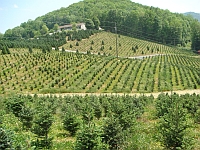 Some pests, such as BWA and EHS are a problem no matter the size of the tree or the time in the rotation. Others are only a problem on young trees (white grubs, RBM) or trees nearing harvest (BTA, Cinara aphids, SSM, HRM). Christmas trees need to have 2 years of pest-free foliage when they are harvested to be considered a good quality tree. This is true whether a tree harvested as a table top or a 20-footer.
Some pests, such as BWA and EHS are a problem no matter the size of the tree or the time in the rotation. Others are only a problem on young trees (white grubs, RBM) or trees nearing harvest (BTA, Cinara aphids, SSM, HRM). Christmas trees need to have 2 years of pest-free foliage when they are harvested to be considered a good quality tree. This is true whether a tree harvested as a table top or a 20-footer.
Pest Control at Planting and the First Year
When planting trees, it’s important to protect trees from white grubs, and to not bring in problem pests such as adelgids or scales. The pests that are important later on in the rotation such as aphids and mites aren’t even considered.
White grubs
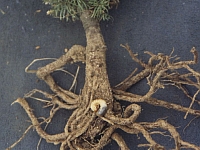 White grubs feed primarily on grass roots. They have also traditionally been a worse problem in fields with a high organic matter in the soil – in other words, rich black dirt. Be sure to scout for grubs in August or September in fields that will be planted either in the fall or the following spring. Scout for grubs by digging holes and sifting through the soil for the presence of grubs. Any size grub is important as small grubs will continue feeding at the site for a year or more. If grubs are present, treat the root system with a bifenthrin dip. For more information on grub control see: Control of Root Feeding Insects in Fraser Fir Christmas Trees (CTN-008).
White grubs feed primarily on grass roots. They have also traditionally been a worse problem in fields with a high organic matter in the soil – in other words, rich black dirt. Be sure to scout for grubs in August or September in fields that will be planted either in the fall or the following spring. Scout for grubs by digging holes and sifting through the soil for the presence of grubs. Any size grub is important as small grubs will continue feeding at the site for a year or more. If grubs are present, treat the root system with a bifenthrin dip. For more information on grub control see: Control of Root Feeding Insects in Fraser Fir Christmas Trees (CTN-008).
Bringing Pests into a Field
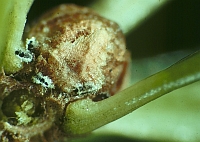
Even seedlings can harbor balsam woolly adelgid or scales.
Back when many people pulled seedlings from Roan Mountain, it was a common recommendation to dip the seedlings in Lindane for BWA control because that pest is so prevalent in the natural stands. Today, seedlings are produced in many different places. Many are grown in the greenhouse, and then lined out for a year or more. That time in the line-out bed can result in exposure to different pests including BWA, EHS, Cryptomeria scale, Phytophthora root rot and potentially other pests. It’s important to inspect plants before planting to make sure they are pest-free. If you have the opportunity to visit seedlings where they are being grown, look at any surrounding fir trees for the presence of pests as a clue to potential problems that seedlings may harbor. Rogue out any pest infested seedlings before planting.
Early in the Rotation
The First Couple of Years
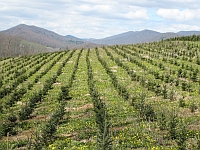 Few pests are a problem in very young trees especially if young trees are not interplanted among older trees. Sometimes, SSM and HRM attack younger trees, especially if they are planted with a southern or western exposure, but damaged foliage will be covered up by new growth. It takes several years for other problem pests to develop.
Few pests are a problem in very young trees especially if young trees are not interplanted among older trees. Sometimes, SSM and HRM attack younger trees, especially if they are planted with a southern or western exposure, but damaged foliage will be covered up by new growth. It takes several years for other problem pests to develop.
Rosette Bud Mites – The Pest to Control Early in the Rotation
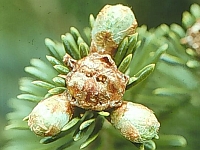
The center bud is a rosette bud.
Early in the rotation, the most important pest to control is RBM because it affects the structure of the tree. If many buds on a tree are rosette buds which do not break and grow, the tree will have gaps and holes in the canopy, uneven growth, and will typically not fill out at the bottom. Typically, once a tree gets larger than 6 feet, the effects of RBM are not as pronounced. There is little need to treat for RBM in trees that will harvested unless the majority of trees will remain in the field for more than two years.
Controlling BWA and EHS in Early Rotation
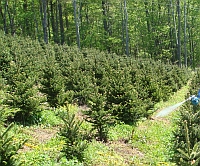 Both the BWA and EHS take several years to build up in a field. In younger trees, it is much easier to spray and get good coverage and therefore good control. However, there should still be caution in using too many insecticides in young trees which can make EHS even worse through an adverse effect on parasitic wasps. Therefore, it is important to do the following to reduce the incidence of BWA and EHS in younger trees.
Both the BWA and EHS take several years to build up in a field. In younger trees, it is much easier to spray and get good coverage and therefore good control. However, there should still be caution in using too many insecticides in young trees which can make EHS even worse through an adverse effect on parasitic wasps. Therefore, it is important to do the following to reduce the incidence of BWA and EHS in younger trees.
- Promote clover in younger trees to provide them with nitrogen requirements. Do not over-fertilize with nitrogen fertilizers.
- Scout to find BWA and EHS to determine when it first comes into trees. To scout for BWA, look for crooked tops. To scout for EHS, assess trees in mid-summer, looking for areas of white on the foliage from the males, turning up foliage to find scales on the underside of needles. Beating foliage over a plate is another way to find scales.
- Consider culling the trees that have EHS or BWA if not many trees are infested.
- Consider spot treating only the areas of the field that have the pests.
- Only treat the entire field for BWA or EHS if these pests are found generally through the field.
Pest Control at the End of Rotation
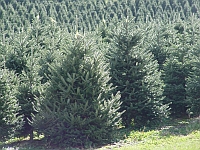 The most critical time for pest control in Christmas trees is the year before sale and the year of sale. In most blocks of trees, growers will take 2 – 3 years to harvest completely. Therefore, it is typically the last 4 -5 years in a rotation where aphids and mites need to be controlled, and the tolerance for EHS is greatly reduced. Choosing the fall treatment window when trees are still a year from harvest, is a good way to protect predators and control pests.
The most critical time for pest control in Christmas trees is the year before sale and the year of sale. In most blocks of trees, growers will take 2 – 3 years to harvest completely. Therefore, it is typically the last 4 -5 years in a rotation where aphids and mites need to be controlled, and the tolerance for EHS is greatly reduced. Choosing the fall treatment window when trees are still a year from harvest, is a good way to protect predators and control pests.
Special Considerations for Seed Orchard Trees
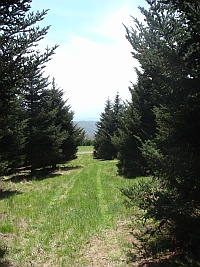 Seed orchard trees don’t have to look pretty; they just have to produce seed. Really the only pest that requires treatment in seed orchard trees is BWA. That is harder, though, as trees are larger and complete coverage is difficult. Yearly treatments are often required, especially if trees are near natural stands or other fields of fir trees. Though the probability of BWA developing resistance to any chemical is low since no males are produced in the US, still it is wise to rotate among different materials. These can include the synthetic pyrethroids such as Asana and Sniper, Safari, Lorsban, and even horticultural oil.
Seed orchard trees don’t have to look pretty; they just have to produce seed. Really the only pest that requires treatment in seed orchard trees is BWA. That is harder, though, as trees are larger and complete coverage is difficult. Yearly treatments are often required, especially if trees are near natural stands or other fields of fir trees. Though the probability of BWA developing resistance to any chemical is low since no males are produced in the US, still it is wise to rotate among different materials. These can include the synthetic pyrethroids such as Asana and Sniper, Safari, Lorsban, and even horticultural oil.


